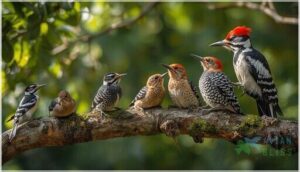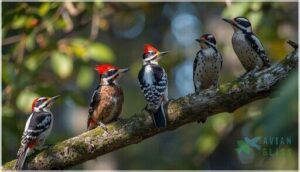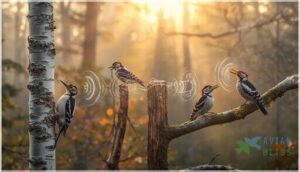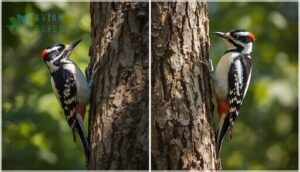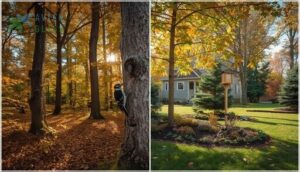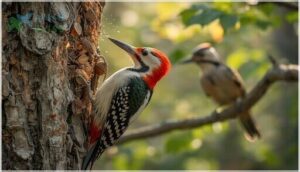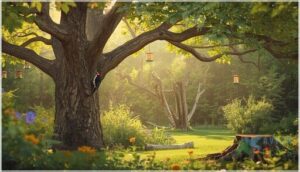This site is supported by our readers. We may earn a commission, at no cost to you, if you purchase through links.
That rhythmic tap-tap-tapping echoing through your backyard isn’t Morse code—it’s one of Massachusetts’ seven resident woodpeckers claiming territory, hunting breakfast, or hollowing out a nest. These bark-climbing acrobats range from the sparrow-sized Downy to the crow-sized Pileated, each species carving out its own niche in the state’s forests and suburbs.
You’ll spot them clinging vertically to tree trunks, their stiff tail feathers acting as a third leg while they drill for beetle larvae hidden beneath the bark. Learning to identify these distinctive birds transforms every woodland walk into a treasure hunt, especially when you know which habitats attract the species you’re after and what field marks separate a Hairy from its smaller Downy cousin.
Table Of Contents
- Key Takeaways
- Common Woodpecker Species in Massachusetts
- Identifying Massachusetts Woodpeckers
- Woodpecker Habitats and Distribution
- Woodpecker Behavior and Diet
- Conservation and Supporting Woodpeckers
- Frequently Asked Questions (FAQs)
- How many types of Woodpeckers are there in Massachusetts?
- Are hairy woodpeckers common in Massachusetts?
- What is the largest woodpecker in Massachusetts?
- Where can you find black backed woodpeckers in Massachusetts?
- Are red-bellied woodpeckers common in Massachusetts?
- Why are woodpeckers important in Massachusetts?
- What kind of woodpeckers are in Massachusetts?
- Do woodpeckers come back to the same place every year?
- Is it good to have woodpeckers in your yard?
- Are there woodpeckers in Massachusetts?
- Conclusion
Key Takeaways
- Massachusetts hosts seven distinct woodpecker species ranging from the sparrow-sized Downy to the crow-sized Pileated, each carving its own ecological niche through specialized foraging and nesting behaviors that transform dead wood into survival opportunities.
- Red-bellied Woodpeckers exploded from near-absence in the 1970s to 75.5% statewide coverage by 2011—a stunning 16,000% population surge driven by warmer winters and habitat adaptation that now makes them common in suburbs and urban parks.
- These birds function as ecosystem engineers whose excavated cavities shelter dozens of other species while their relentless insect hunting delivers natural pest control that can slash beetle populations by up to 98% in Massachusetts forests.
- You can directly support woodpecker populations by leaving dead trees standing, planting native vegetation like Red Maple to boost insect availability, skipping pesticides, and providing suet feeders during winter months when natural food sources dwindle.
Common Woodpecker Species in Massachusetts
Massachusetts is home to seven woodpecker species, each with its own distinct look and behavior. You’ll find everything from the common Downy Woodpecker tapping away in your backyard to the rare Red-headed Woodpecker that only a few lucky birders spot.
Let’s break down each species so you know exactly what to look for on your next walk through the woods.
Downy Woodpecker
You’ll spot the Downy Woodpecker everywhere across Massachusetts—it’s the smallest woodpecker in North America and a champion of insect consumption. Males flash a distinctive red head patch that females lack.
With around 13 million birds continent-wide and population stability holding strong since 1970, these adaptable foragers excel at nest excavation in dead limbs, thriving in both woodlands and your backyard. They’re known to occupy a variety of habitats, requiring mature trees for nesting.
Hairy Woodpecker
The Hairy Woodpecker looks like the Downy’s bigger sibling—but that chisel-like beak tells a different story. Breeding increase across Massachusetts shows real momentum, with occupancy jumping from 66.5% to 83.3% of surveyed blocks. Hairy Woodpeckers are often found in mature coniferous forests.
- Medium-sized with striking black-and-white patterned plumage
- Diet specialization: 75% insect larvae, especially wood-boring beetles
- Thrives in mature mixed forests and suburban woodlots
- Population trends show consistent growth since the 1970s
Northern Flicker
Look for this large woodpecker hopping on the ground—not clinging to bark like most species. Northern Flickers devour more ants than any bird in Massachusetts, with ant consumption driving their ground-foraging habits.
You’ll find them in open forests, yards, and forest edges. Despite wide distribution across the state, breeding bird surveys show a troubling 49% population decline since 1966, making every sighting count.
Pileated Woodpecker
The Pileated Woodpecker—Massachusetts’ largest woodpecker—sports a striking red crest and crow-sized body. You’ll encounter them in deciduous forests and mature woodlands, where their diet composition centers on carpenter ants—up to 60% of their intake.
Habitat expansion has been impressive: breeding blocks jumped from 18.6% to 53.5% between the 1970s and 2011, with population trends showing over 1.5% annual growth.
Red-bellied Woodpecker
The Red-bellied Woodpecker—despite its misleading name—showcases a bright red cap and black-and-white barred back you’ll recognize instantly. This species’ range expansion in Massachusetts has been nothing short of striking, with breeding occupancy skyrocketing from just 3 isolated blocks in the 1970s to 75.5% statewide coverage by 2011.
Here’s what makes identification straightforward:
- Males display red from bill to nape; females show red only on the nape
- Buff-brown chest and face with subtle belly tinge
- White wing patches visible during flight
- Length ranges from 22.85 to 26.7 cm with 38–46 cm wingspan
Their habitat adaptation is impressive—you’ll find them in open second-growth woods, mixed forests, suburban shade trees, and even urban parks. Population increase has been most dramatic in lowland regions, where forest edges meet river corridors and swamps.
Feeding habits reveal their opportunistic nature. More than 50% of their diet consists of plant material—acorns, nuts, seeds, and fruits—supplemented by beetles and larvae they extract from bark. They’ll visit your feeders for peanut butter and sunflower seeds, storing extra food in bark crevices for winter.
Conservation status remains stable with populations continuing to expand northward, likely due to warmer winters and changing forest composition. This represents the most dramatic increase of any breeding bird species in Massachusetts since 1979.
Yellow-bellied Sapsucker
Unlike most woodpeckers in Massachusetts, the Yellow-bellied Sapsucker migrates through the state, drilling neat horizontal rows of sap wells in birch and maple trees. You’ll spot their distinctive black-and-white face pattern with red crown and throat patch.
Their ecological impact extends beyond personal feeding—those sap wells attract hummingbirds, warblers, and insects, creating feeding stations for multiple species. Conservation status remains stable across their northeastern breeding range.
Red-headed Woodpecker (Rare)
You’re unlikely to encounter this stunning bird—the Red-headed Woodpecker ranks as Massachusetts’ rarest breeding woodpecker species. With striking tricolored plumage, it appears mainly as a sporadic migrant rather than a resident. Habitat loss and population decline throughout the Eastern United States have made breeding irregularity the norm. Conservation status reflects its tenuous hold here, a shadow of its historic range.
Identifying features include:
- Bold red head covering entire crown and neck
- Crisp white underparts contrasting with jet-black back
- Large white wing patches visible in flight
- Preference for open woodlands with standing dead trees
Identifying Massachusetts Woodpeckers
Spotting a woodpecker in your backyard is one thing—knowing which species you’re looking at is another. Each woodpecker has its own set of telltale signs, from size and coloring to the sounds they make while foraging.
Let’s break down the key features that’ll help you identify these birds with confidence.
Physical Characteristics and Size
Woodpeckers in Massachusetts vary dramatically in size. You’ll spot tiny Downy Woodpeckers measuring just 14–18 cm in length with 25–31 cm wingspans and weighing around 20–33 g. Compare that to the crow-sized Pileated Woodpecker, stretching 40–49 cm long with 66–75 cm wingspans and tipping scales at 225–400 g.
Northern Flickers, Hairy Woodpeckers, and Red-bellied Woodpeckers fall somewhere between these extremes.
Distinctive Plumage and Color Patterns
You’ll notice each species wears its own signature outfit. Downy Woodpeckers sport stark black and white patterns with white backs, while males flash a small red patch behind the head. Hairy Woodpeckers look similar but feature unmarked white outer tail feathers and a bold black shoulder spur.
Northern Flickers break the mold entirely—brownish plumage with black spots, a black chest crescent, and yellow underwings mark eastern birds.
Pileated Woodpeckers command attention with dramatic red crests and white facial stripes against black bodies.
Red-bellied Woodpeckers showcase barred black-and-white backs; males display extensive red from crown to nape, while females show red only on the nape.
Yellow-bellied Sapsuckers reveal black-and-white barring, large white wing patches, and red foreheads—males add red throats to the mix.
Sound Patterns and Calls
Listen closely and you’ll catch each species broadcasting its own sonic fingerprint. Drumming and calls serve as key clues when trees block your view. Learning these sound patterns transforms any woodland walk into an acoustic treasure hunt.
Key sound signatures to track:
- Downy Woodpeckers rattle off about 17 beats per second in short 1.5-second bursts, plus a quick “pik” call
- Hairy Woodpeckers drum faster at 24–26 beats per second with a sharp “peek” note
- Northern Flickers deliver rolling rattles lasting up to 8 seconds
- Pileated Woodpeckers boom out dramatic sequences of 10–30 knocks, especially at sunrise
Acoustic monitoring reveals these species signatures work best during early morning hours.
Differences Between Similar Species
Once you’ve nailed the sounds, sight-based woodpecker identification becomes paramount. Size comparison separates Downy (6.5 inches) from Hairy (9.25 inches), though habitat overlap complicates field IDs. Plumage variations matter too—check outer tail feathers for black spots on Downies versus pure white on Hairies.
Behavior contrasts help: Northern Flickers forage on the ground while Red-bellied Woodpeckers stick to trunks. These identification challenges demand sharp eyes and patience.
Woodpecker Habitats and Distribution
Knowing where to find woodpeckers in Massachusetts makes all the difference between a frustrating search and a successful sighting. Each species has its own favorite haunts, from deep forests to your backyard feeder.
Let’s explore where these birds live, how their ranges shift with the seasons, and which spots give you the best chance of spotting them.
Preferred Forest Types
In Massachusetts, woodpecker habitats depend heavily on forest age and tree composition. Mature forests—those 50 years or older—host 45% more Pileated Woodpeckers than younger stands. You’ll find the highest diversity in old growth forests with mixed oak, maple, and hickory.
Snag density matters too: standing dead trees create essential nesting sites. Wetland forests and carefully managed forest ecosystems in Massachusetts support thriving populations across all species.
Urban and Suburban Sightings
You don’t need a forest to find woodpeckers in Massachusetts—suburban areas host thriving populations. Downy Woodpeckers, nearly ubiquitous across tree-lined neighborhoods, lead the pack in urban sightings. Red-bellied numbers have exploded 16,000% in three decades, colonizing suburbs statewide. Northern Flickers forage on lawns for ants, while Pileateds now drum in Boston Basin parks.
Building damage and noise complaints spike in spring when birds target cedar siding. Garden foraging and species adaptation make birdwatching in Massachusetts suburbs surprisingly rewarding.
Range Maps and Regional Hotspots
Understanding where woodpeckers thrive helps you plan successful outings. Range maps reveal striking patterns across the state:
- Worcester Plateau hotspots: Pileated Woodpecker blocks jumped from 23% to 97% coverage in thirty years, making Quabbin and Wachusett Reservoirs prime viewing locations.
- Red-bellied expansion: Now common statewide except Cape Cod, with highest concentrations in eastern and central regions.
- Rarity alert: Red-headed Woodpeckers remain confined to scattered Plymouth and Bristol County sightings.
Seasonal Movements
Most Massachusetts woodpeckers stick around all year, but you’ll notice seasonal shifts. Yellow-bellied Sapsuckers migrate south by October, while climate influence has transformed Red-bellied Woodpeckers from rare visitors into year-round residents—a stunning 16,000% population shift since the 1980s.
Migration triggers like temperature drops send Northern Flickers southward each fall, creating prime birdwatching opportunities as these migratory birds pass through diverse habitats.
Woodpecker Behavior and Diet
Watching a woodpecker at work reveals just how specialized these birds really are. From the way they hunt to how they claim territory, every behavior has a purpose tied to survival.
Here’s what you need to know about their daily routines and what keeps them going.
Foraging Techniques and Diet
You’ll find that woodpecker feeding habits adapt remarkably throughout the year. Insect foraging dominates spring and summer, with species like the Downy consuming over 70% wood-boring larvae. Seasonal shifts bring dramatic changes—Red-bellied Woodpeckers switch to 80% plant material by winter.
Tool use is impressive: those barbed tongues extract prey from deep bark crevices, while Yellow-bellied Sapsuckers drill sap wells that attract insects. Prey composition varies widely, but their foraging habits consistently support forest health by removing destructive beetle larvae.
Drumming and Drilling Behaviors
During spring courtship, you’ll witness rapid-fire territorial displays when males drum up to 23 beats per second on resonant dead trunks. This drumming communication establishes boundaries and attracts mates through sexual selection.
Drilling energetics differ entirely—woodpeckers excavate nest cavities with hammer-like force over 12–15 days. Substrate resonance matters: they’ll choose birch or maple for best sound projection, occasionally causing woodpecker damage to buildings when natural sites disappear.
Nesting and Breeding Habits
You’ll notice cavity nesting starts between April and June, when both parents excavate fresh holes in dead snags. Breeding patterns vary—Red-bellied Woodpeckers prefer standing deadwood, while Pileateds chisel cavities up to 24 inches deep.
Here’s what makes their nesting habits notable:
- Clutch size ranges from 3–8 pure white eggs depending on species
- Parental care is shared equally, with males generally incubating overnight
- Fledging period lasts 21–31 days after hatching
- Nest success improves dramatically with greater cavity height
- Nesting cavities get reused by other wildlife after woodpeckers move on
Interactions With Other Wildlife
Woodpeckers act as ecosystem engineers, reshaping forest health through cavity competition and foraging facilitation. Their excavations attract chickadees and nuthatches, while sap sharing brings hummingbirds to Yellow-bellied Sapsucker wells.
Their pest control efforts reduce beetle populations by up to 98%, creating wildlife habitats that support diverse avian fauna and strengthen insect control across Massachusetts woodlands.
Conservation and Supporting Woodpeckers
Woodpeckers face real challenges in Massachusetts, from habitat loss to declining food sources. But here’s the good news—you can make a difference right in your own backyard.
Woodpeckers face real threats in Massachusetts, but you can help them thrive right in your own backyard
Let’s look at the threats these birds deal with, what’s being done to help them, and the simple steps you can take to support your local woodpecker populations.
Threats to Woodpecker Populations
You’re watching forests shrink right before your eyes. In Massachusetts, habitat loss and habitat destruction are squeezing woodpecker populations hard. Invasive species like European Starlings steal nest sites, while climate change shifts traditional ranges.
Pesticide use wipes out insect prey, and nest competition grows fiercer. Forest pests kill nesting trees, leaving fewer places for woodpeckers to raise their young.
Conservation Efforts in Massachusetts
The good news? Massachusetts wildlife conservation is fighting back with serious action planning. The State Wildlife Action Plan now tracks 619 species and unlocks federal grants for habitat protection. Here’s what’s happening on the ground:
- Mass Audubon monitors population trends across the state
- MassWildlife develops targeted plans for cavity-nesting birds
- “Foresters for the Birds” links logging to woodpecker conservation
- Private landowners get guidance on climate resilience strategies
- Forest management prioritizes snag retention statewide
You’re part of this effort whether you realize it or not.
Creating Woodpecker-Friendly Habitats
You can create a woodpecker haven right at home. Plant native vegetation like Red Maple and Canadian Serviceberry to boost insect populations. Leave dead trees standing—they’re prime real estate for cavity nesters. Skip pesticides to protect the bugs woodpeckers hunt.
Add suet-filled bird feeders in winter, and watch your yard transform into conservation territory.
How Residents Can Help
Beyond creating habitat, your everyday actions ripple through Massachusetts bird conservation. Join citizen science programs to track woodpecker populations across the state. Set up backyard feeders with suet blends, especially in winter. Support tree planting initiatives in your neighborhood. When woodpeckers cause issues, use non-lethal deterrent methods—legal protections prohibit harm. Here’s how you can make a real difference:
- Report woodpecker sightings through biodiversity tracking platforms
- Install bird feeders year-round for consistent food sources
- Volunteer with habitat restoration projects
- Advocate for preserving dead trees in public spaces
- Share what you learn about attracting woodpeckers to your backyard
Frequently Asked Questions (FAQs)
How many types of Woodpeckers are there in Massachusetts?
Seven woodpecker species call Massachusetts home. Six breed regularly across the state—Downy, Hairy, Northern Flicker, Pileated, Yellow-bellied Sapsucker, and Red-bellied—while the Red-headed Woodpecker remains a rare local breeder.
Are hairy woodpeckers common in Massachusetts?
Hairy Woodpeckers have hammered their way into nearly every corner of Massachusetts. This species expanded from 66% to 83% of the state between the 1970s and 2011, making them decidedly common.
What is the largest woodpecker in Massachusetts?
The Pileated Woodpecker claims the title as Massachusetts’ largest woodpecker species, measuring an impressive 16–19 inches long with a wingspan reaching nearly 30 inches—roughly the size of an American Crow.
Where can you find black backed woodpeckers in Massachusetts?
You won’t find Black-backed Woodpeckers easily here—they’re ghosts in our forests.
These rare woodpecker species appear only after disturbance regimes like fires reshape boreal habitats, creating brief irruption events in northern Massachusetts.
Are red-bellied woodpeckers common in Massachusetts?
Yes, they’re now abundant throughout Massachusetts. This redbellied woodpecker species has undergone a dramatic population increase—from rare to widespread—thanks to habitat expansion and urban adaptation, making them easily spotted in most lowland regions.
Why are woodpeckers important in Massachusetts?
Woodpeckers serve as ecosystem engineers, creating cavities that dozens of species depend on.
They deliver natural pest control by hunting wood-boring insects, keeping forests healthy while supporting broader conservation goals across the ecosystem.
What kind of woodpeckers are in Massachusetts?
Massachusetts hosts a rich tapestry of woodpecker species—six common nesters including Downy, Hairy, Northern Flicker, Pileated, Yellow-bellied Sapsucker, and Red-bellied Woodpecker, plus the rare Red-headed Woodpecker.
Do woodpeckers come back to the same place every year?
It depends on the species. Resident birds like Downy and Pileated Woodpeckers show strong site fidelity, often returning to the same nesting territory.
Migratory species follow less predictable patterns influenced by habitat quality and climate impact.
Is it good to have woodpeckers in your yard?
They’ll hammer your siding yet gift you free pest control—the quintessential uninvited guests.
Woodpeckers in Massachusetts suburban backyards bring keystone species benefits like habitat creation and bird diversity, despite occasional property damage requiring prevention strategies.
Are there woodpeckers in Massachusetts?
Yes, six species regularly nest across the state, with diverse habitats supporting populations statewide. Regional distribution varies by forest type, but seasonal presence remains consistent for most year-round residents throughout Massachusetts.
Conclusion
Watching woodpeckers weave through Massachusetts’ forests and backyards reveals nature’s blueprint for resilience—these birds thrive wherever dead wood and insects intersect.
You’ve now got the field marks, habitat clues, and behavioral tells to separate species at a glance. Whether you’re planting native trees or leaving snags standing, your choices directly shape which woodpeckers of Massachusetts claim your corner of the Commonwealth.
Every drum roll overhead means you’re doing something right.
- https://www.mass.gov/info-details/learn-about-woodpeckers
- https://www.massaudubon.org/our-work/birds-wildlife/bird-conservation-research/breeding-bird-atlases/find-a-bird?id=3356
- https://newenglandforestry.org/winter-woodpeckers/
- https://avibirds.com/woodpeckers-of-massachusetts/
- https://www.facebook.com/groups/413227880972276/posts/967523475542711/


